
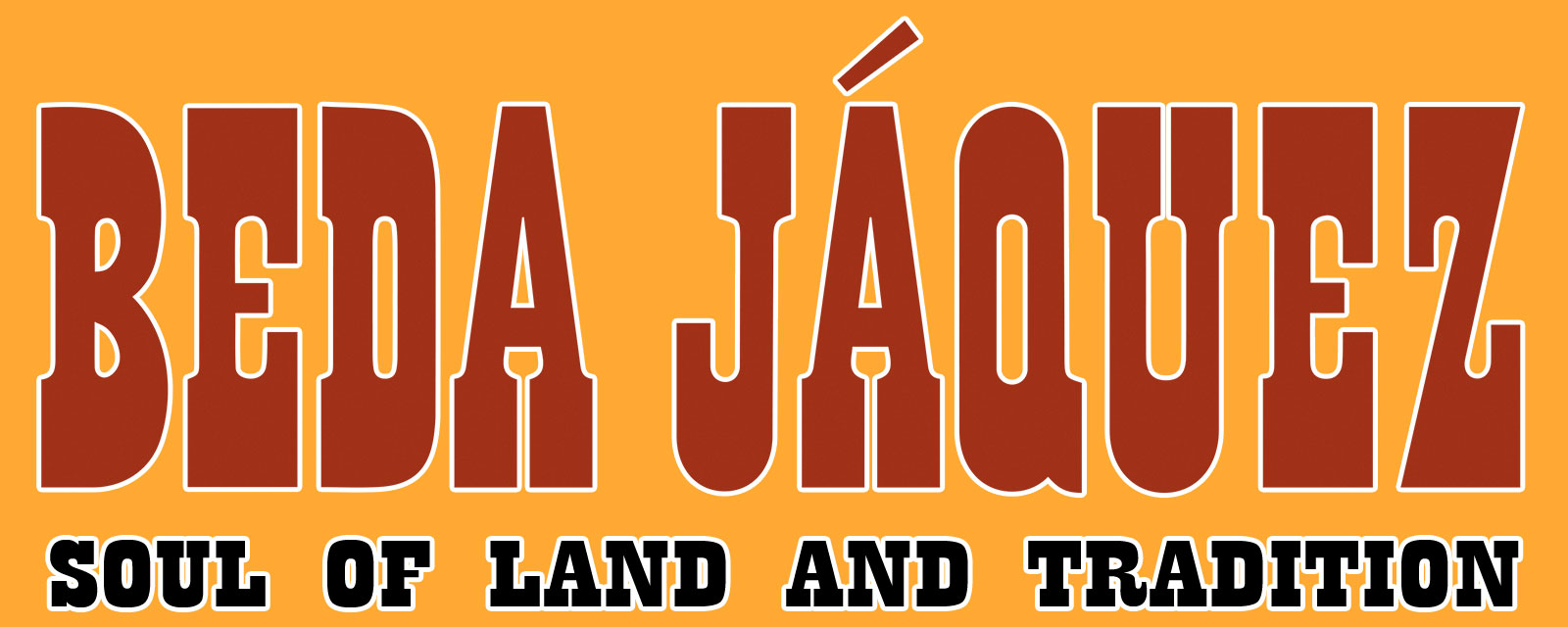
Chihuahua, nombre que define un territorio conformado por dilatadas extensiones desérticas interrumpidas por las frescas vegas de los pocos ríos que mitigan su sed, así mismo, praderas con generosos pastizales y, también, la agreste serranía. Un espacio que templará el carácter de sus habitantes, cuyo esfuerzo y acción queda impreso en su modo de ser estrechamente ligado a la tierra.
La conquista y colonización del Septentrión novohispano fue motivada, inicialmente, por la ambición del oro y la plata más que de tierras. Este empeño impulsó el descubrimiento de ricas vetas creando el Real de minas, la misión y el presidio, núcleos de población demandantes de alimentos, iniciando así la agricultura y la ganadería. Las minas se agotaron, pero permaneció el medio rural, especialmente la ganadería en franco desarrollo, creando una cultura con usos y costumbres presentes aún en la actualidad. Rasgos que conforman el carácter de los chihuahuenses.
Alma de tierra y tradición, obra pictórica en la que el arte sublima el quehacer de seres humanos poseedores de un espíritu indómito, que ponen rienda a la adversidad para dar continuidad al noble oficio de la ganadería Chihuahuense. Solamente quien emerge de la íntima relación con la tierra posee la sensibilidad para imprimir en un lienzo fragmentos sustanciales de la vida campirana. Así, el talento de Beda Jaquez, - originaria de Santa María de Cuevas, lugar donde la naturaleza traslapa desierto y pradera – recrea en su creación pictórica la ancestral relación entre hombre y caballo, así mismo, imágenes del entorno vital de los actores en el escenario rural, su manera de ser y vivir.
Gonzalo R. García Terrazas
Chihuahua, a name that defines a territory made up of vast expanses of desert interrupted by the cool plains of the few rivers that quench their thirst, as well as meadows with generous grasslands and, also, the rugged mountains. A space that will temper the character of its inhabitants, whose effort and action is imprinted in their way of being closely linked to the land.
The conquest and colonization of the North of New Spain was motivated, initially, by the ambition for gold and silver rather than land. This effort promoted the discovery of rich veins, creating the Real de Minas, the mission and the presidio, population centers demanding food, thus initiating agriculture and livestock. The mines were exhausted, but the rural environment remained, especially livestock farming in rapid development, creating a culture with uses and customs present even today. Traits that make up the character of Chihuahuans.
Soul of land and tradition, a pictorial work in which art sublimates the work of human beings possessing an indomitable spirit, who rein in adversity to give continuity to the noble profession of Chihuahuan livestock. Only those who emerge from the intimate relationship with the land have the sensitivity to print substantial fragments of country life on a canvas. Thus, the talent of Beda Jaquez, - originally from Santa María de Cuevas, a place where nature overlaps desert and prairie - recreates in her pictorial creation the ancestral relationship between man and horse, as well as images of the actors' living environment in the rural setting, their way of being and living.
And so it shows us the cowboy and the pasture, it also evokes the corner of a corral, its bars or a window with a shutter and wrought iron bars in a forge; the doorway of an old door in some town in our state, and invites us to enter fresh hallways with the scent of geraniums and honeysuckle and water distillers with the flavor of stone. The work of Beda Jaquez is a loving caress for the soul of our beloved Chihuahuan land and its traditions.
Gonzalo R. García Terrazas
Semblanza
Alma de tierra y tradición es una exposición pictórica de la artista chihuahuense Beda Jáquez, cuyo trabajo se distingue por exaltar el valor del ámbito rural como parte esencial del patrimonio cultural del estado. A través de una pintura realista y emotiva, Jáquez plasma la vida del campo y la ganadería en Chihuahua, reflejando el esfuerzo, la identidad y el carácter de sus habitantes. Su obra rinde homenaje a las raíces que han forjado la historia y la esencia de esta región.
Originaria de Santa María de Cuevas, Beda Jáquez transforma en arte su íntima conexión con la tierra, recreando escenas que capturan la relación entre el ser humano, el caballo y el paisaje chihuahuense. En cada lienzo, la figura del vaquero se convierte en símbolo de nobleza y perseverancia, mientras los elementos del entorno corrales, portones, ventanas y praderas, evocan la memoria viva de una tradición que sigue latiendo en el corazón del norte.
Profile
Soul of land and tradition is a pictorial exhibition by the Chihuahuan artist Beda Jáquez, whose work is distinguished by exalting the value of the rural area as an essential part of the state's cultural heritage. Through realistic and emotional painting, Jáquez captures the life of the countryside and livestock in Chihuahua, reflecting the effort, identity and character of its inhabitants. His work pays tribute to the roots that have forged the history and essence of this region.
Originally from Santa María de Cuevas, Beda Jáquez transforms her intimate connection with the land into art, recreating scenes that capture the relationship between humans, horses and the Chihuahuan landscape. In each canvas, the figure of the cowboy becomes a symbol of nobility and perseverance, while the elements of the surroundings, corrals, gates, windows and meadows, evoke the living memory of a tradition that continues to beat in the heart of the North.
La ganadería en Chihuahua
La historia ganadera en el territorio que hoy es Chihuahua se remonta al siglo XVI, cuando Cristóbal Colón introdujo en América los primeros ejemplares de ganado caballar, bovino y caprino (1493), los cuales se adaptaron con rapidez. A partir de 1519, con la llegada de Hernán Cortés a Veracruz, se dio inicio a la expansión ganadera en la Nueva España. Para 1522 se estableció en Atenco la primera ganadería formal y, hacia 1529, se reglamentó el uso de fierros para marcar al ganado, base del registro ganadero novohispano.
A partir de las expediciones de Francisco de Ibarra, en 1561, se establecieron los primeros hatos y estancias en el norte de la Nueva España, especialmente en Santa Bárbara y Valle de San Bartolomé.
Durante los siglos XVII y XVIII, las misiones jesuitas consolidaron la cría de ganado bovino, ovino y porcino en la región serrana. A finales del periodo virreinal ya existían haciendas ganaderas que sustentaban la economía local, aunque las sequías afectaban periódicamente la producción.
En el siglo XIX, la ganadería se fortaleció con la introducción de razas europeas y la modernización de los métodos de cría. Luis Terrazas impulsó el desarrollo del sector y, hacia 1900, Chihuahua era uno de los principales productores del país. Tras la Revolución Mexicana, la actividad se reorganizó mediante asociaciones ganaderas y programas de fomento a la pequeña propiedad.
A mediados del siglo XX se incorporaron nuevas razas y técnicas de inseminación artificial, consolidando el mejoramiento genético del hato. Con la creación de la Escuela de Ganadería y la Expogan, Chihuahua reafirmó su papel protagónico en la ganadería nacional.
Hoy, tras más de cuatro siglos de historia, la ganadería forma parte esencial del patrimonio cultural y productivo del estado, reflejo de su identidad, su territorio y su vocación de trabajo.
Livestock farming in Chihuahua
The history of livestock farming in what is now Chihuahua dates back to the 16th century, when Christopher Columbus introduced the first horses, cattle, and goats to the Americas (1493), which adapted quickly. Starting in 1519, with the arrival of Hernán Cortés in Veracruz, livestock farming began to expand in New Spain. By 1522, the first formal cattle ranch was established in Atenco, and around 1529, the use of branding irons for livestock was regulated, forming the basis of the livestock registry in New Spain.
Starting with the expeditions of Francisco de Ibarra in 1561, the first cattle ranches and estates were established in northern New Spain, especially in Santa Bárbara and Valle de San Bartolomé.
During the 17th and 18th centuries, Jesuit missions consolidated cattle, sheep, and pig farming in the mountainous region. By the end of the viceroyalty period, there were already cattle ranches that sustained the local economy, although droughts periodically affected production.
In the 19th century, livestock farming was strengthened by the introduction of European breeds and the modernization of breeding methods. Luis Terrazas promoted the development of the sector, and by 1900, Chihuahua was one of the country's leading producers. After the Mexican Revolution, the industry was reorganized through livestock associations and programs to promote small land ownership.
In the mid-20th century, new breeds and artificial insemination techniques were introduced, consolidating the genetic improvement of the herd. With the creation of the School of Livestock and the Expogan livestock show, Chihuahua reaffirmed its leading role in the national livestock industry.
Today, after more than four centuries of history, livestock farming is an essential part of the state's cultural and productive heritage, reflecting its identity, its territory and its work ethic.
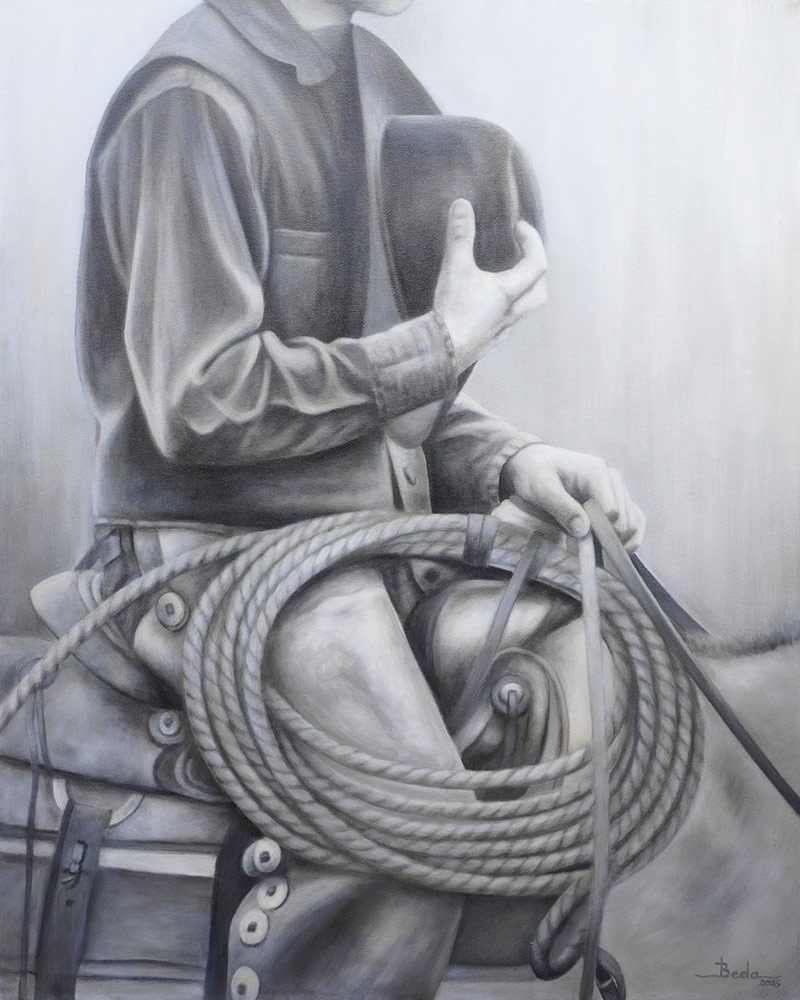
2025
100×80cm Gratitude
2025
40"×32"
Gracias por la tierra, bendícenos con la lluvia.
En el silencio del campo, el vaquero no clama con voz,
sino con gratitud en el pecho y esperanza en el corazón.
Porque quien vive del campo sabe que la lluvia no es solo agua... es vida.
Thank you for the land, bless us with rain
In the silence of the countryside, the cowboy does'nt cry out with a voice,
but with gratitude in the chest and hope in the heart.
Because those who subsist on the countryside know that rain is not only water... it is life.
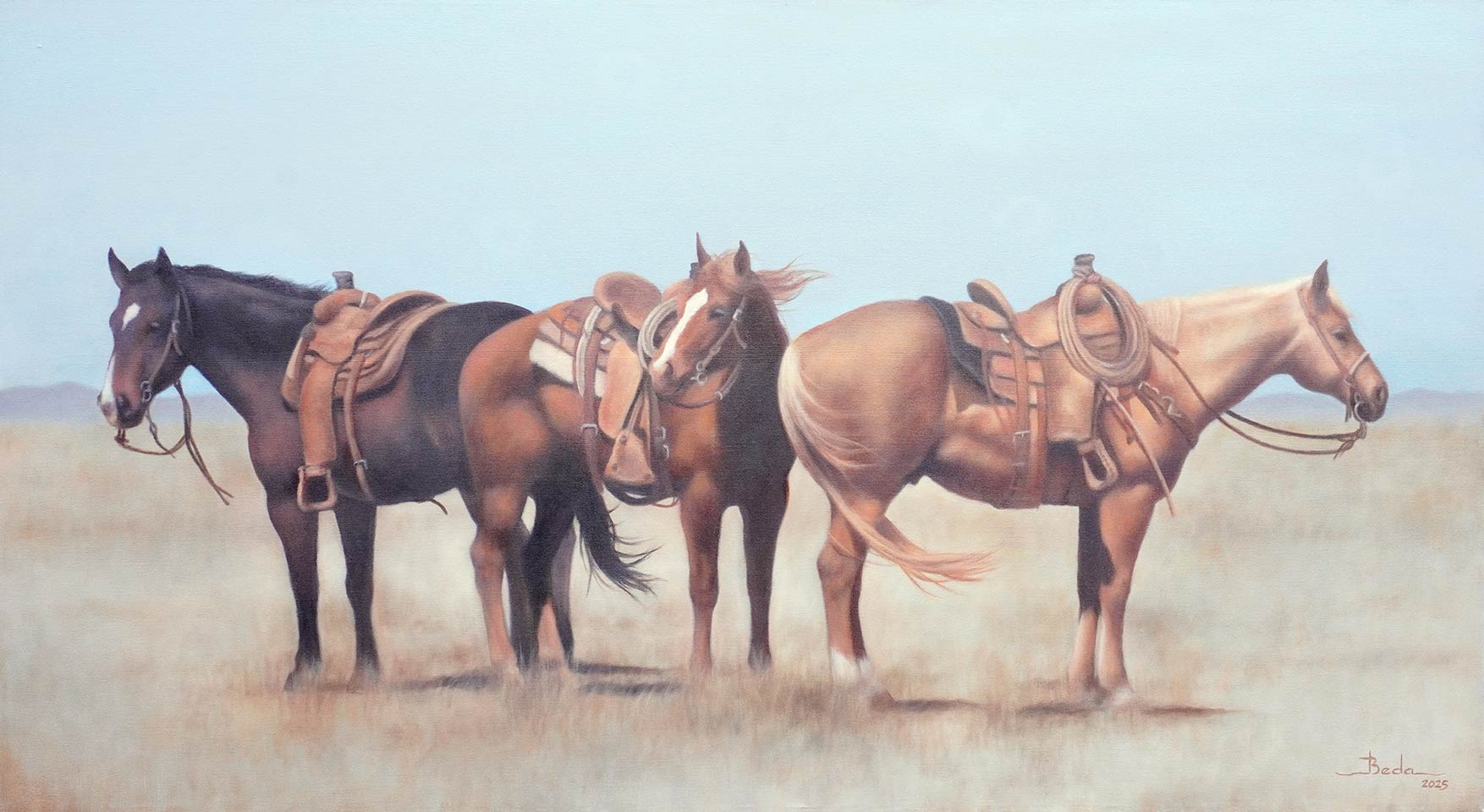
2025
65×120cm Day Companions
2025
25"×48"
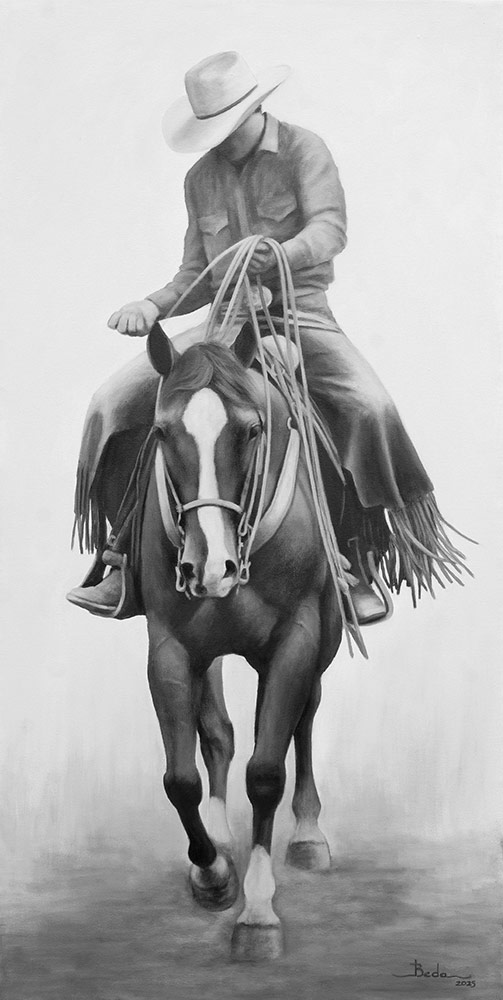
2025
115×55cm With the Day in Tow
2025
45"×22"
Después de una larga jornada, el vaquero regresa con el cuerpo cansado y el alma llena.
No hay palabras, solo el sonido de la rienda,
el suspiro del caballo y la tierra que cruje bajo sus pasos.
After a long day, the cowboy returns with tired body and full soul.
There are no words, just the sound of the rein,
the sigh of the horse and the soil that rustles under its steps.
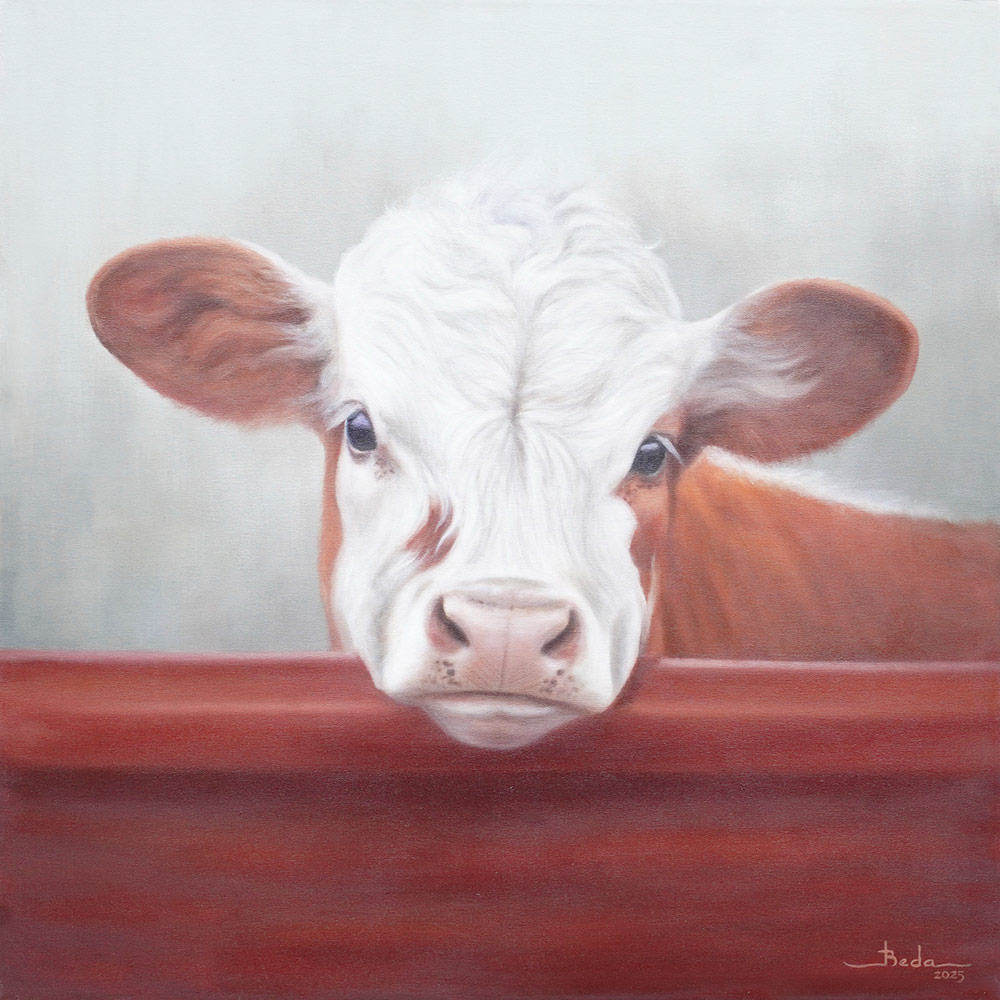
2025
70×70cm Shine of Tenderness
2025
28"×28"

2025
65×85cm Snooping
2025
26"×33"
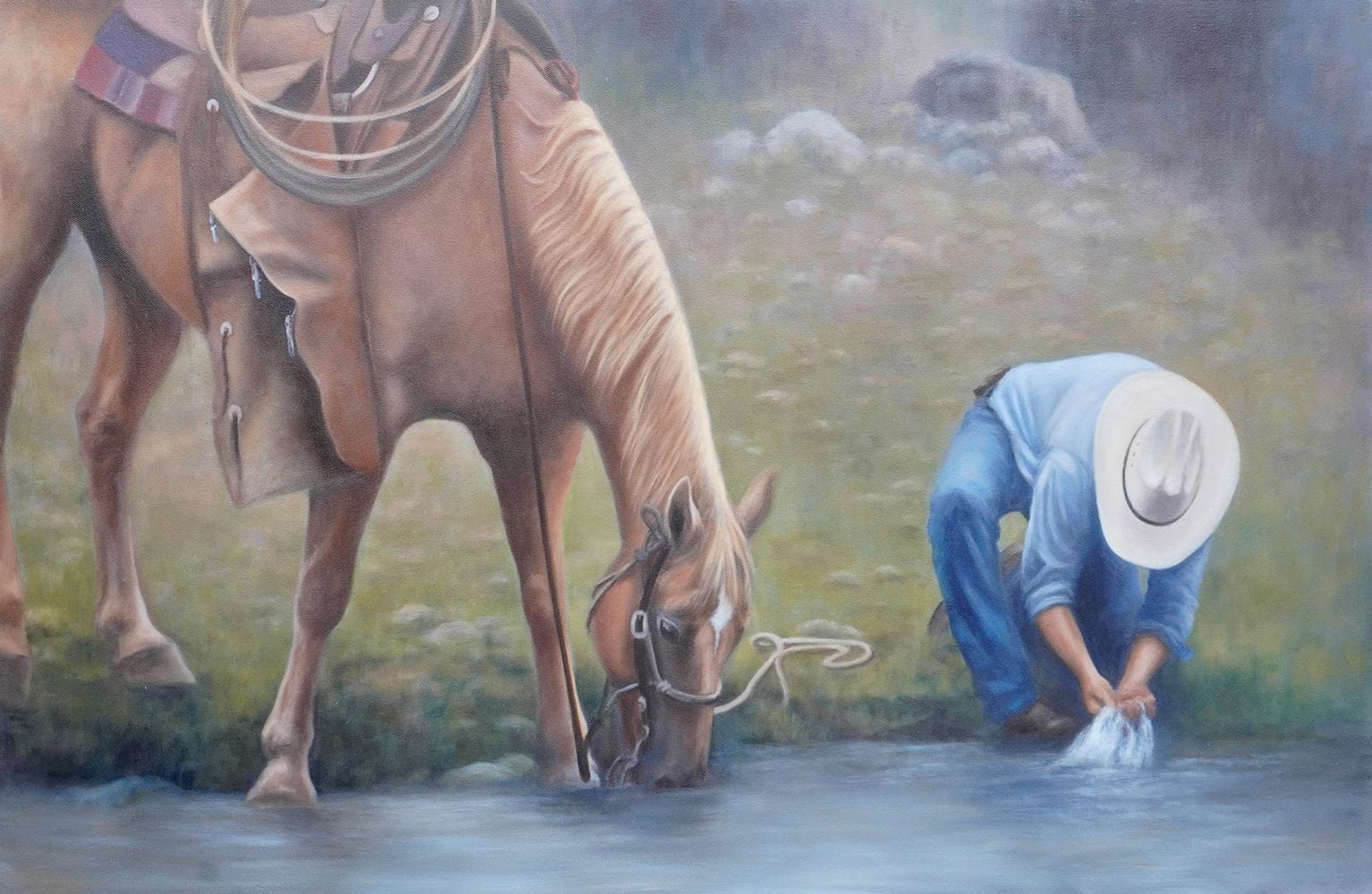
2025
70×115cm Respite in the Creek
2025
28"×45"
En medio de la jornada el vaquero encuentra en el agua un respiro.
Su caballo bebe, él refresca sus manos:
un instante sencillo, pero profundo, donde la naturaleza y el trabajo se reconcilian en calma.
In the middle of the day the cowboy finds respite in water.
His horse drinks, he refreshes his hands:
a simple but profound moment, where nature and work are reconciled in calmness.
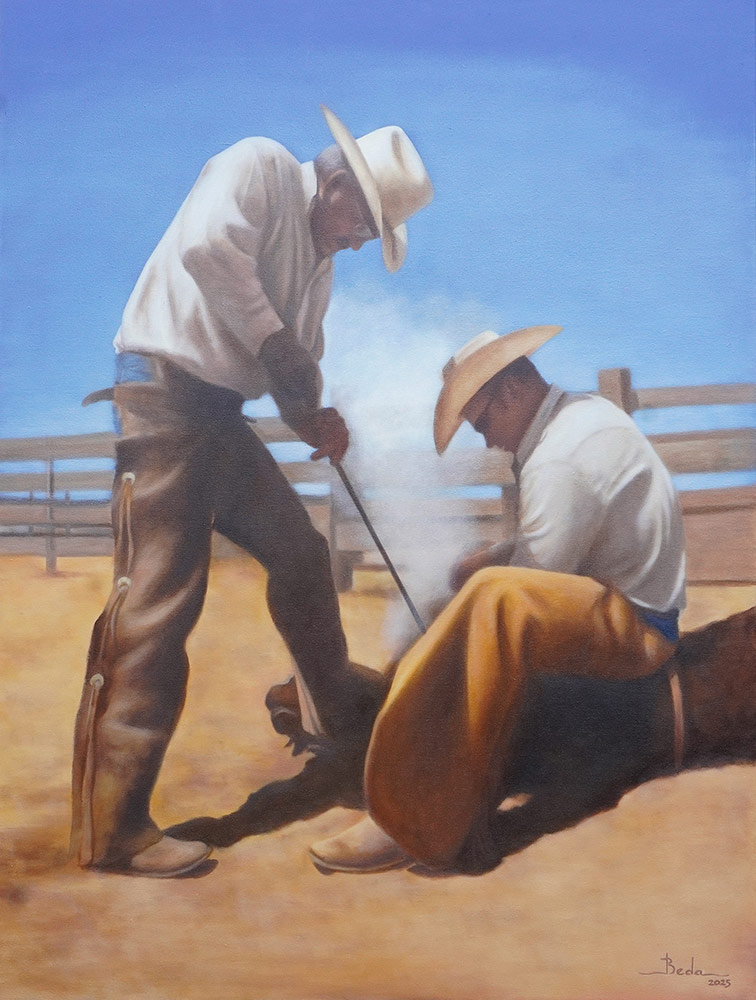
2025
90×70cm Branding
2025
36"×28"
Faena de fuego y esfuerzo, une al vaquero con su ganado.
Trabajo de manos firmes que sellan tradición y permanencia.
A labor of fire and effort unites the cowboy with his cattle.
The work of steady hands that brand tradition and permanence.

2023
60×80cm The Task Begins
2023
24"×32"
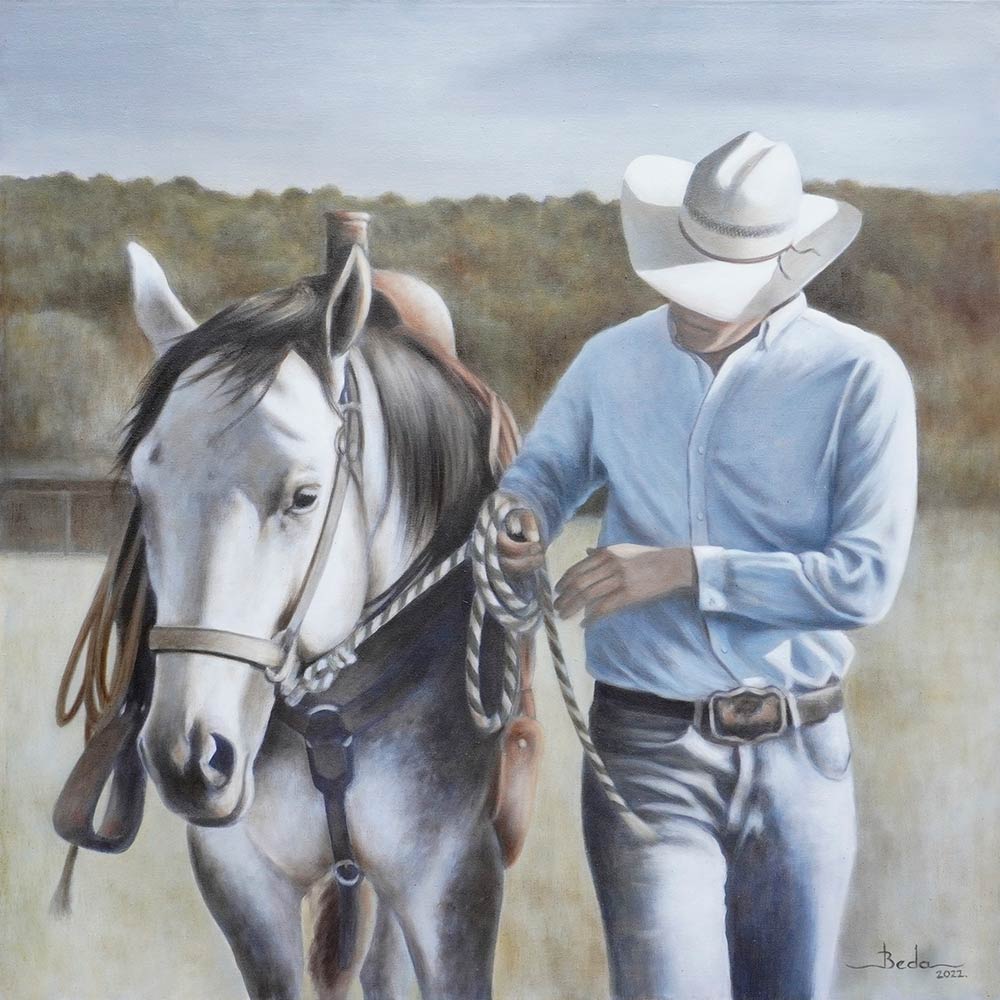
2022
80×80cm Soul and Rein
2022
32"×32"
En el caminar sereno se refleja la grandeza del campo:
el vaquero y el caballo, fuerza y corazón.
In their serene gait the grandeur of the countryside is reflected:
the cowboy and his horse, strength and heart.

2025
70×90cm Heading to the Corral
2025
28"×36"
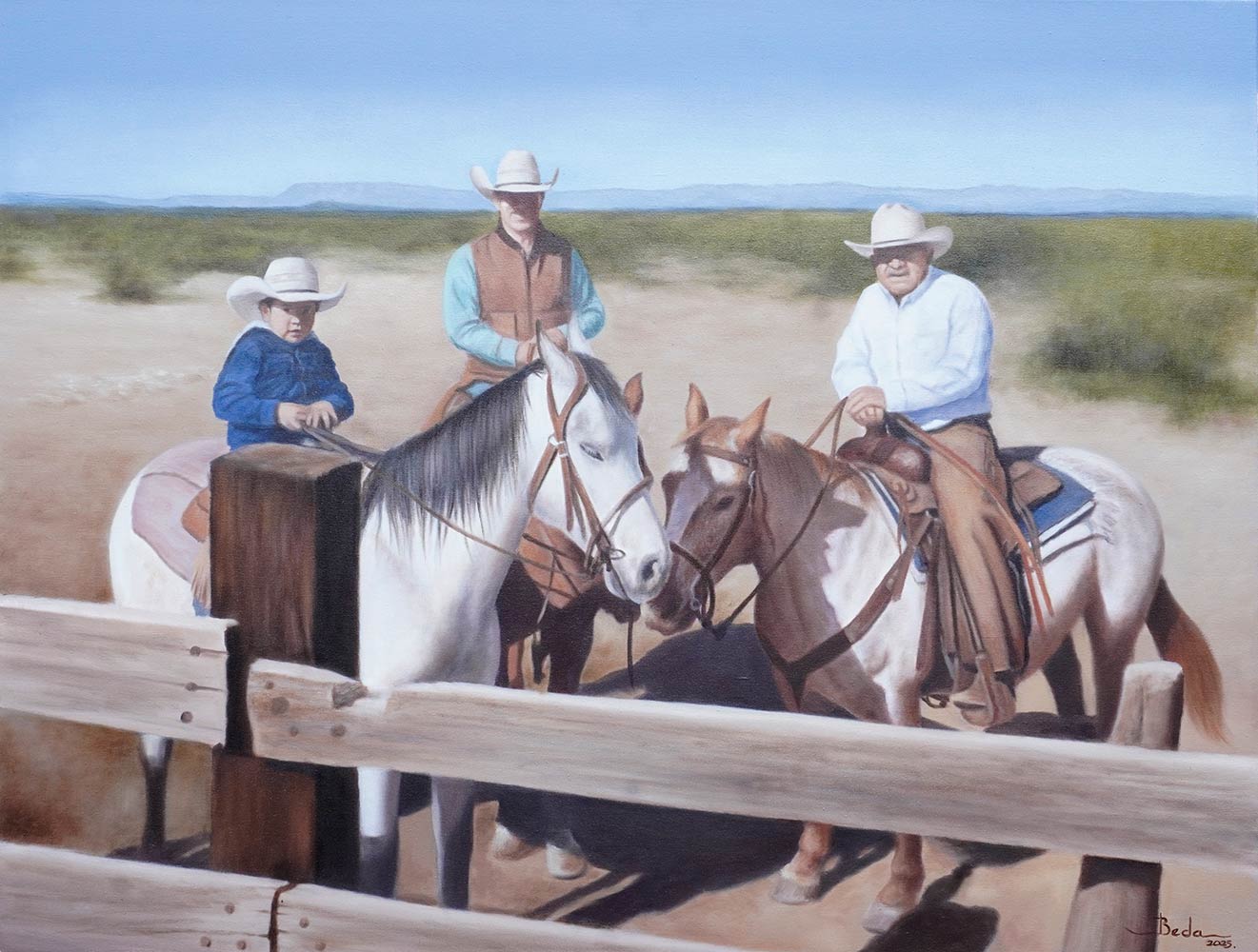
2025
70×90cm Shared Tradition
2025
28"×36"
Tres generaciones cabalgan juntas, más allá de la faena.
La imagen evoca la herencia de valores, el orgullo de las raíces
y la continuidad de una forma de vida que se transmite de corazón a corazón.
El campo no solo se trabaja, también se vive y se honra.
Three generations ride together, beyond the work itself.
The image evokes a legacy of values, pride in their roots,
and the continuity of a way of life passed down from heart to heart.
The range is not only worked, it is also lived and honored.
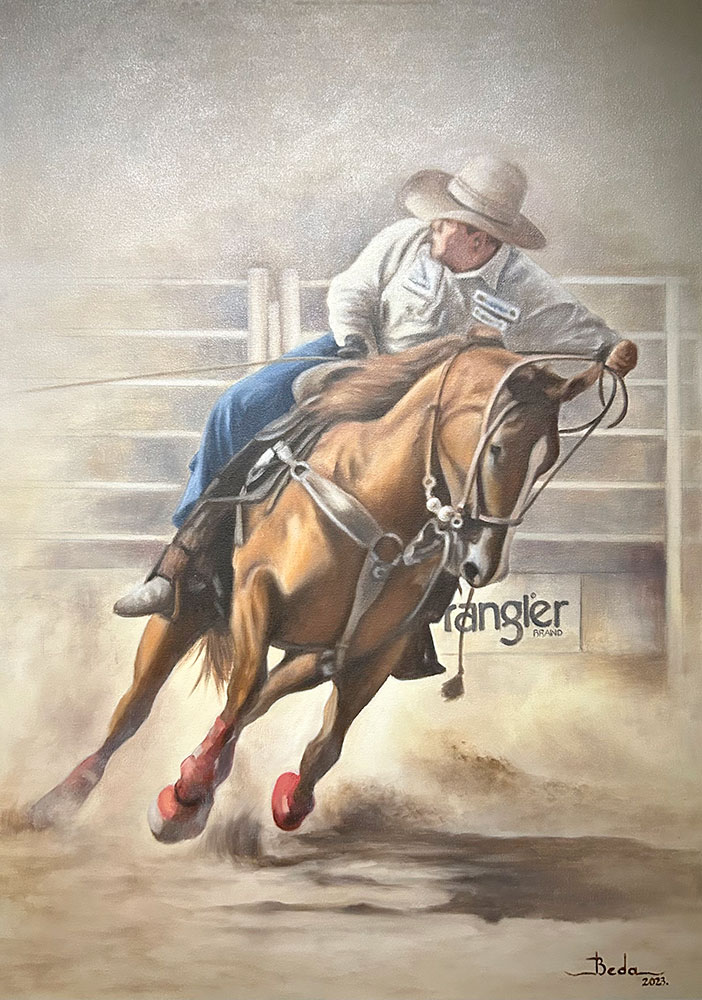
2023
70×50cm Among Dust and Courage
2023
28"×20"
El ruedo es un torbellino,
el polvo que se levanta bajo sus patas
simboliza la dureza del terreno y la crudeza del instante,
mientras que el coraje del vaquero refleja la pasión y entrega.
Esta obra es un tributo a la intensidad del rodeo,
donde la pasión se mide en segundos
y el coraje se escribe con polvo en el viento.
The arena is a whirlwind,
the dust rising beneath the hooves
symbolizes the harshness of the terrain and the rawness of the moment,
while the cowboy's courage reflects passion and dedication.
This work is a tribute to the intensity of the rodeo,
where passion is measured in seconds
and courage is written with dust in the wind.
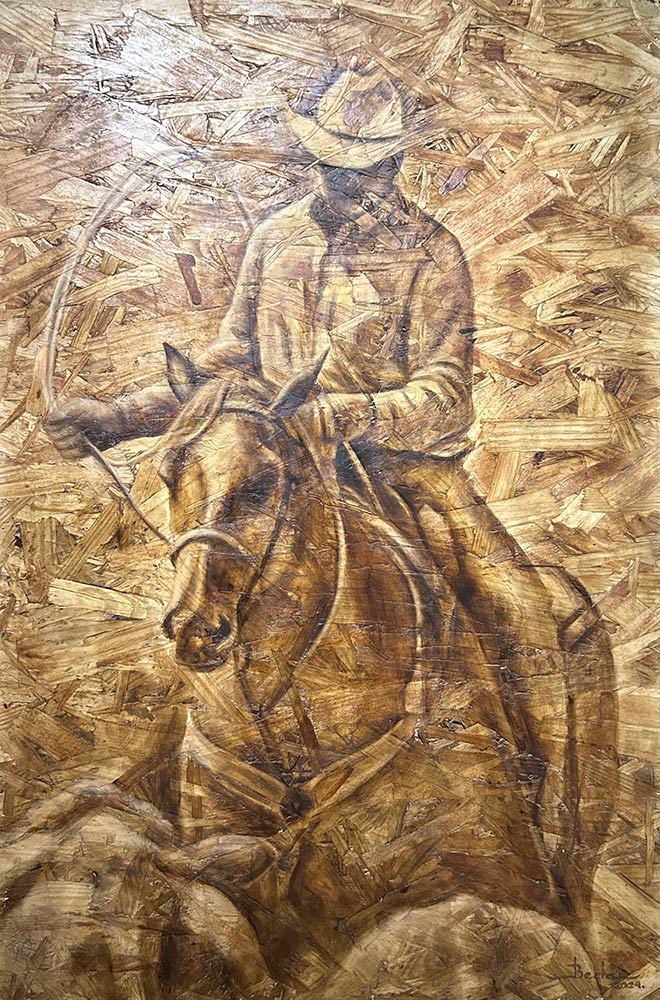
2024
90×60cm The Following One
2024
36"×24"
Entre polvo, sudor y coraje, el vaquero no se detiene.
El lazo gira, el caballo responde, y la mirada anuncia que ya esta listo.
En el ruedo no hay pausas ni esperas: cada instante exige desición.
El vaquero sabe que siempre habrá un nuevo reto, una nueva presa, un nuevo horizonte.
Amidst dust, sweat, and courage, the cowboy doesn't stop.
The lasso twirls, the horse responds, and its gaze announces it's ready.
In the arena, there are no pauses or waiting: every moment demands decision.
The cowboy knows there will always be a new challenge, a new prize, a new horizon.
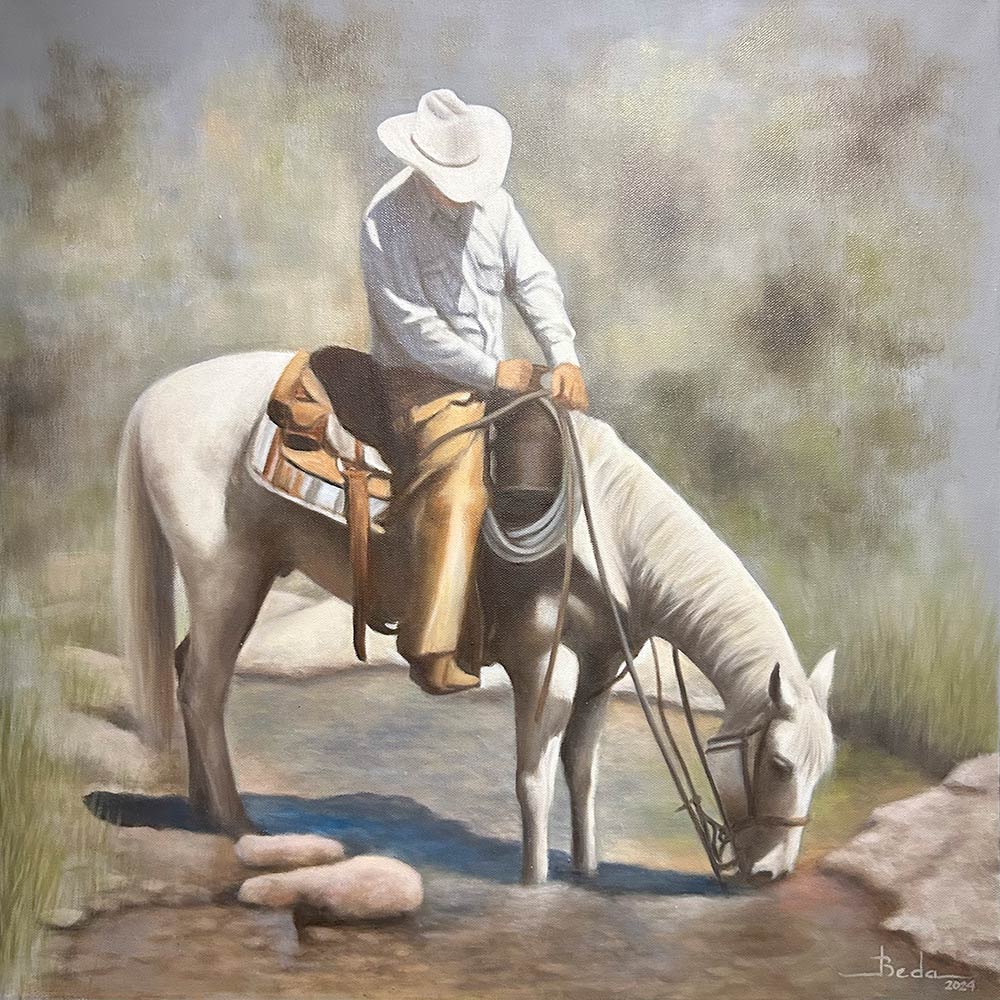
2024
60×60cm In the Water Hole
2024
24"×24"


Exposición individual de pintura
del 31 de octubre de 2025 al 2 de febrero de 2026.
Individual painting exhibit
from October 31, 2025 through February 2, 2026.
